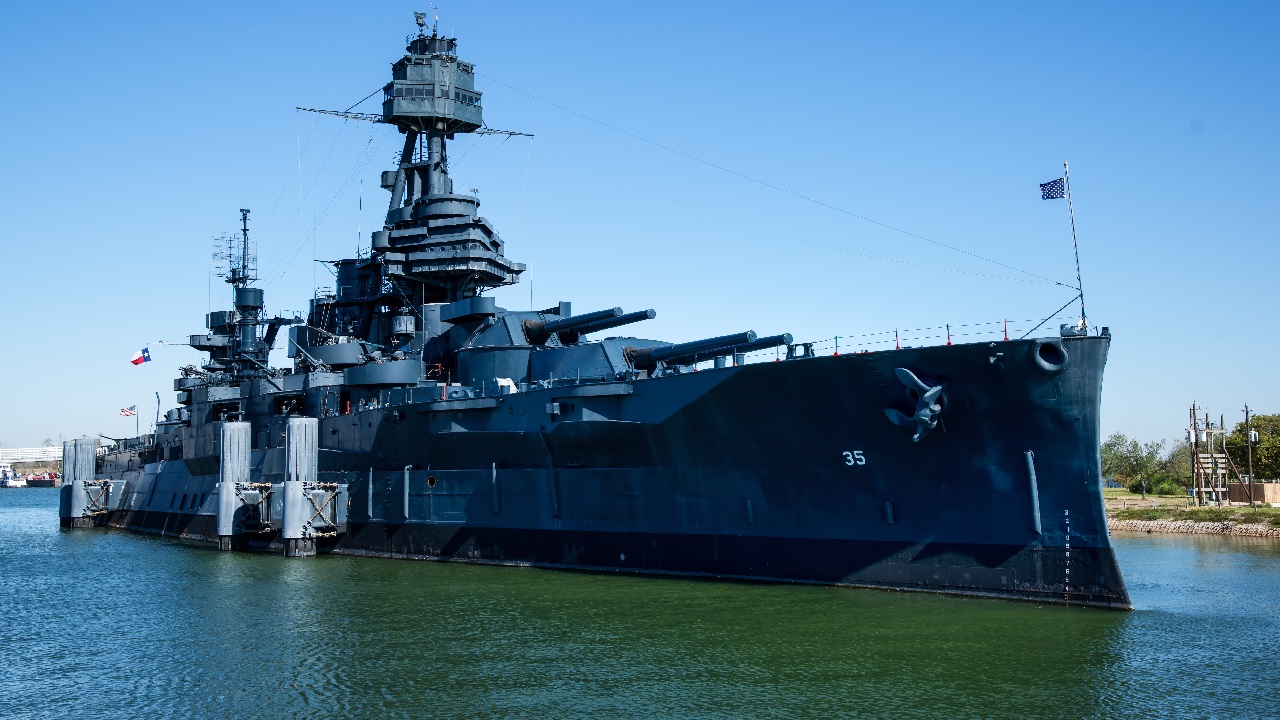Battleship USS Texas Prepares for Much Needed Repairs – During her three and a half decades in service, USS Texas (BB-35) had logged many miles around the globe – serving as the fleet and division flagship during United States Navy U.S. Fleet exercises in 1937, while she alternated operations between the Atlantic and Pacific Oceans.
Launched in 1912, she provided escort and blockade duties in the Atlantic Ocean during the First World War, and in April 1917, while protecting the merchant vessel Mongolia, fired on a surfaced German U-Boat – the first American shots of the conflict.
Following the First World War, USS Texas proved to be the perfect testbed for the U.S. Navy, and in March 1919 she became the first U.S. battleship to fly off an aircraft – a British Sopwith Camel – from a temporary platform that had been fitted atop her second turret. The warship subsequently underwent a major reconstruction from 1925 to 1927, and the ship was reboilered with six Bureau-Express oil-fired units. These included numerous improvements to her combat systems, and USS Texas was the first U.S. battleship to mount anti-aircraft guns and the first U.S. vessel to control gunfire with directors and range-keepers. Following the modernization, Texas alternated operations between the Atlantic and Pacific Oceans until 1931, when her base was shifted to California.
Back to War
During the Second World War, BB-35 took part in convoy duties that carried Lend-Lease material to the United Kingdom and was part of Task Group 34.8 (TG 34.8) in support of Operation Torch, the Allied invasion of North Africa. It was from USS Texas that Lt. General Dwight D. Eisenhower transmitted his first “Voice of Freedom” broadcast, which called up the Vichy French forces not to oppose the Allied landings.
In addition, as a young news reporter, Walter Cronkite was among those onboard the battleship during the operations and was even granted permission to fly off of the ship in one of her OS2U Kingfisher aircraft.
The aging battle wagon was later among the warships to provide supporting fire during the Normandy landings. She also participated in the bombardment of Cherbourg, during which she was hit by enemy coastal artillery fire but suffered no serious damage. After undergoing repairs in Plymouth, England she took part in the allied invasion of the South of France during Operation Dragoon in August 1944. Following an overhaul in New York City, which involved replacing her main battery barrels; USS Texas returned to the Pacific and later provided naval gunfire support during the Battles of Iwo Jima and Okinawa.
USS Texas is the last remaining battleship in the world to have seen service in both World Wars.
Efforts to Preserve USS Texas
After the war, many great U.S. battleships were sold for scrap, or used as target ships, but USS Texas was spared such a fate, and after her decommissioning in 1948, she became a museum ship and the first permanent battleship memorial museum in the United States. Since April of that year, she’s been moored in the Houston Ship Channel near the San Jacinto Monument – near the location where Texian troops led by Gen. Sam Houston surprised and quickly defeated the Mexican Army in 1836.
Today Battleship Texas, as she is now known, is the official – but entirely ceremonial – flagship of the Texas Navy.
However, all those decades spent in the water have taken their toll on the old battle wagon, and in June 2017, a six-by-eight-inch hole about fifteen feet below the waterline opened and caused the ship to list six degrees. The situation was so dire that there were concerns the ship could sink! Fortunately, work has been taken to ensure that the warship won’t be lost to the elements.
This month, The Battleship Texas Foundation, with its partners, the Texas Parks and Wildlife Department and Texas Historical Commission, announced that the Battleship Texas will be departing San Jacinto Battleground State Historic Site for repairs in mid-August. Efforts have been underway since May when crews began to remove about 23,000 cubic yards of mud from the stern around the ship to clear a path for towing.
According to the foundation, repairs will be done at Gulf Copper and Manufacturing Corporations’ Galveston Shipyard.
The exact date is currently pending, but San Jacinto Battleground State Historic Site, parts of Independence Parkway, and the Lynchburg Ferry will be closed to the public while the ship is moved. However, officials have said that the transit should be viewable from the shoreline most of the day.
After the restorations are completed, it isn’t clear where the ship will be preserved for future generations but it won’t be the San Jacinto Battleground Historic Site. Instead, Galveston has been suggested as the most likely destination, while Corpus Christi has also been suggested. Some veterans have also championed Galveston as it was the original home of the Texas Navy, dating back to when Texas was a republic, while Seawolf Park is located on Galveston’s Pelican Island. The park currently houses the World War II submarine USS Cavalla and one of only three destroyer escorts in the world, the USS Stewart.
A Senior Editor for 1945, Peter Suciu is a Michigan-based writer who has contributed to more than four dozen magazines, newspapers and websites. He regularly writes about military hardware, firearms history, cybersecurity, and international affairs. Peter is also a Contributing Writer for Forbes. You can follow him on Twitter: @PeterSuciu.

